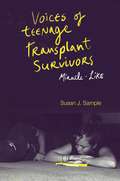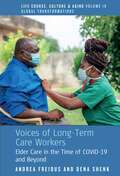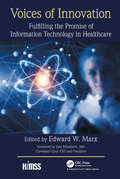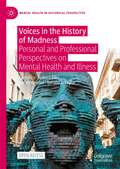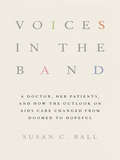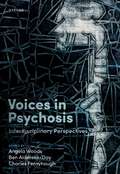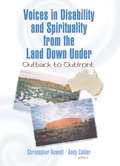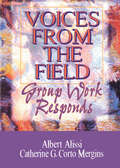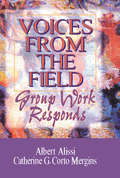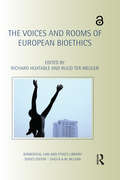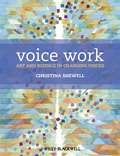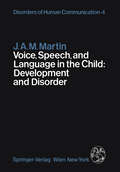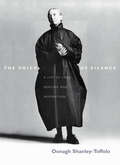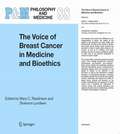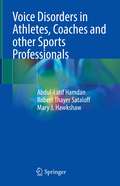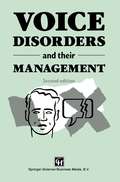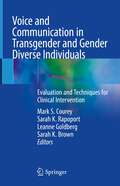- Table View
- List View
Voices of Teenage Transplant Survivors: Miracle-Like
by Susan J. SampleWhile the physical and emotional trials of waiting on transplant lists are featured in popular media, the struggles recipients face years after surgery are not. Voices of Teenage Transplant Survivors introduces illness narratives from an unrecognized patient population: recipients of heart, liver, and kidney transplants. Offering unique narratives by adolescents who use poetry to explore issues surrounding the changing body, independence, identity, and mortality, the book showcases a message of healing and voices of hope amid uncertainty. Illuminating the physical, psychological, and existential challenges confronted by adolescents for which organ rejection and side effects loom in their future, Sample details the poetry workshops where these adolescents articulated experiences silenced by family, friends, and the culture of medicine. She includes close readings and analyses of their writings, along with writing prompts and references to narrative medicine theory. This powerful book offers something new for medical and health professionals, medical humanities researchers, students, and the public.
Voices of Teenage Transplant Survivors: Miracle-Like
by Susan J. SampleWhile the physical and emotional trials of waiting on transplant lists are featured in popular media, the struggles recipients face years after surgery are not. Voices of Teenage Transplant Survivors introduces illness narratives from an unrecognized patient population: recipients of heart, liver, and kidney transplants. Offering unique narratives by adolescents who use poetry to explore issues surrounding the changing body, independence, identity, and mortality, the book showcases a message of healing and voices of hope amid uncertainty. Illuminating the physical, psychological, and existential challenges confronted by adolescents for which organ rejection and side effects loom in their future, Sample details the poetry workshops where these adolescents articulated experiences silenced by family, friends, and the culture of medicine. She includes close readings and analyses of their writings, along with writing prompts and references to narrative medicine theory. This powerful book offers something new for medical and health professionals, medical humanities researchers, students, and the public.
Voices of Long-Term Care Workers: Elder Care in the Time of COVID-19 and Beyond (Life Course, Culture and Aging: Global Transformations #10)
by Andrea Freidus Dena ShenkThere were many challenges, successes, and concerns in providing long-term care to older adults during the COVID-19 pandemic. Looking at central North Carolina, the authors highlight the implications of providing long-term care to older Americans, with an emphasis on the importance of communication, resilience of staff, and value of human infrastructure. Based on extensive interviews, this collection of essays reflects on the participants’ individual experiences and represents the voices of staff and caregivers working in long-term residential care communities, in-home and community-based programs, as well as regional aging service providers and advocates.
Voices of Long-Term Care Workers: Elder Care in the Time of COVID-19 and Beyond (Life Course, Culture and Aging: Global Transformations #10)
by Andrea Freidus Dena ShenkThere were many challenges, successes, and concerns in providing long-term care to older adults during the COVID-19 pandemic. Looking at central North Carolina, the authors highlight the implications of providing long-term care to older Americans, with an emphasis on the importance of communication, resilience of staff, and value of human infrastructure. Based on extensive interviews, this collection of essays reflects on the participants’ individual experiences and represents the voices of staff and caregivers working in long-term residential care communities, in-home and community-based programs, as well as regional aging service providers and advocates.
Voices of Long-Term Care Workers: Elder Care in the Time of COVID-19 and Beyond (Life Course, Culture and Aging: Global Transformations #10)
by Andrea Freidus Dena ShenkThere were many challenges, successes, and concerns in providing long-term care to older adults during the COVID-19 pandemic. Looking at central North Carolina, the authors highlight the implications of providing long-term care to older Americans, with an emphasis on the importance of communication, resilience of staff, and value of human infrastructure. Based on extensive interviews, this collection of essays reflects on the participants’ individual experiences and represents the voices of staff and caregivers working in long-term residential care communities, in-home and community-based programs, as well as regional aging service providers and advocates.
Voices of Innovation: Fulfilling the Promise of Information Technology in Healthcare (HIMSS Book Series)
by Edward W. MarxWe can all point to random examples of innovation inside of healthcare information technology, but few repeatable processes exist that make innovation more routine than happenstance. How do you create and sustain a culture of innovation? What are the best practices you can refine and embed as part of your organization's DNA? What are the potential outcomes for robust healthcare transformation when we get this innovation mystery solved? Loaded with numerous case studies and stories of successful innovation projects, this book helps the reader understand how to leverage innovation to help fulfill the promise of healthcare information technology in enabling superior business and clinical outcomes.
Voices of Innovation: Fulfilling the Promise of Information Technology in Healthcare (HIMSS Book Series)
by Edward W. MarxWe can all point to random examples of innovation inside of healthcare information technology, but few repeatable processes exist that make innovation more routine than happenstance. How do you create and sustain a culture of innovation? What are the best practices you can refine and embed as part of your organization's DNA? What are the potential outcomes for robust healthcare transformation when we get this innovation mystery solved? Loaded with numerous case studies and stories of successful innovation projects, this book helps the reader understand how to leverage innovation to help fulfill the promise of healthcare information technology in enabling superior business and clinical outcomes.
Voices of Innovation: Fulfilling the Promise of Information Technology in Healthcare (HIMSS Book Series)
by Edward W. MarxWe can all point to random examples of innovation inside of healthcare information technology, but few repeatable processes exist that make innovation more routine than happenstance. How do you create and sustain a culture of innovation? What are the best practices you can refine and embed as part of your organization's DNA? What are the potential outcomes for robust healthcare transformation when we get this innovation mystery solved? Loaded with numerous case studies and stories of successful innovation projects, this book helps the reader understand how to leverage innovation to help fulfill the promise of healthcare information technology in enabling superior business and clinical outcomes.
Voices in the History of Madness: Personal and Professional Perspectives on Mental Health and Illness (Mental Health in Historical Perspective)
by Robert Ellis Steven J. Taylor Sarah KendalThis book presents new perspectives on the multiplicity of voices in the histories of mental ill-health. In the thirty years since Roy Porter called on historians to lower their gaze so that they might better understand patient-doctor roles in the past, historians have sought to place the voices of previously silent, marginalised and disenfranchised individuals at the heart of their analyses. Today, the development of service-user groups and patient consultations have become an important feature of the debates and planning related to current approaches to prevention, care and treatment. This edited collection of interdisciplinary chapters offers new and innovative perspectives on mental health and illness in the past and covers a breadth of opinions, views, and interpretations from patients, practitioners, policy makers, family members and wider communities. Its chronology runs from the early modern period to the twenty-first century and includes international and transnational analyses from Europe, North America, Asia and Africa, drawing on a range of sources and methodologies including oral histories, material culture, and the built environment.Chapter 4 is available open access under a Creative Commons Attribution 4.0 International License via link.springer.com.
Voices in the Band: A Doctor, Her Patients, and How the Outlook on AIDS Care Changed from Doomed to Hopeful (The Culture and Politics of Health Care Work)
by Susan C. Ball"I am an AIDS doctor. When I began that work in 1992, we knew what caused AIDS, how it spread, and how to avoid getting it, but we didn't know how to treat it or how to prevent our patients' seemingly inevitable progression toward death. The stigma that surrounded AIDS patients from the very beginning of the epidemic in the early 1980s continued to be harsh and isolating. People looked askance at me: What was it like to work in that kind of environment with those kinds of people? My patients are 'those kinds of people.' They are an array and a combination of brave, depraved, strong, entitled, admirable, self-centered, amazing, strange, funny, daring, gifted, exasperating, wonderful, and sad. And more. At my clinic most of the patients are indigent and few have had an education beyond high school, if that. Many are gay men and many of the patients use or have used drugs. They all have HIV, and in the early days far too many of them died. Every day they brought us the stories of their lives. We listened to them and we took care of them as best we could."—from the IntroductionIn 1992, Dr. Susan C. Ball began her medical career taking care of patients with HIV in the Center for Special Studies, a designated AIDS care center at a large academic medical center in New York City. Her unsentimental but moving memoir of her experiences bridges two distinct periods in the history of the epidemic: the terrifying early years in which a diagnosis was a death sentence and ignorance too often eclipsed compassion, and the introduction of antiviral therapies that transformed AIDS into a chronic, though potentially manageable, disease. Voices in the Band also provides a new perspective on how we understand disease and its treatment within the context of teamwork among medical personnel, government agencies and other sources of support, and patients. Deftly bringing back both the fear and confusion that surrounded the disease in the early 1990s and the guarded hope that emerged at the end of the decade, Dr. Ball effectively portrays the grief and isolation felt by both the patients and those who cared for them using a sharp eye for detail and sensitivity to each patient's story. She also recounts the friendships, humor, and camaraderie that she and her colleagues shared working together to provide the best care possible, despite repeated frustrations and setbacks. As Dr. Ball and the team at CSS struggled to care for an underserved population even after game-changing medication was available, it became clear to them that medicine alone could not ensure a transition from illness to health when patients were suffering from terrible circumstances as well as a terrible disease.
Voices in Psychosis: Interdisciplinary Perspectives
by Angela Woods, Ben Alderson-Day and Charles FernyhoughVoice-hearing experiences associated with psychosis are highly varied, frequently distressing, poorly understood, and deeply stigmatised, even within mental health settings. Voices in Psychosis responds to the urgent need for new ways of listening to and making sense of these experiences. It brings multiple disciplinary, clinical, and experiential perspectives to bear on an original and extraordinarily rich body of testimony: transcripts of forty in-depth phenomenological interviews conducted with people who hear voices and who have accessed Early Intervention in Psychosis services. The book addresses the social, clinical, and research contexts in which the interviews took place, thoroughly investigating the embodied, multisensory, affective, linguistic, spatial, and relational qualities of voice-hearing experiences. The nature, politics, and consequences of these analytic endeavours is a focus of critical reflection throughout. Each chapter gives a multifaceted insight into the experiences of voice-hearers in the North East of England and to their wider resonance in contexts ranging from medieval mysticism to Amazonian shamanism, from the nineteenth-century novel to the twenty-first century survivor movement. By deepening and extending our understanding of hearing voices in psychosis in a striking way, the book will be an invaluable resource not only for academics in the field, but for mental health practitioners and members of the voice-hearing community. An open access title available under the terms of a CC BY-NC-ND 4.0 International licence.
Voices in Disability and Spirituality from the Land Down Under: Outback to Outfront
by Christopher NewellAn excellent source of information and ideas on the relationship between disability and spirituality-and how to improve itThis one-of-a-kind collection explores the relationship between spirituality and disability from a variety of Australian religious and spiritual viewpoints. Authors from a wide range of backgrounds-some with disabilities, some without-draw remarkable insights from Christian, Jewish, Buddhist (and even non-religious) spirituality. These uniquely Australian perspectives provide practical and spiritual lessons that can be applied in any part of the world.Voices in Disability and Spirituality from the Land Down Under presents an unflinching look at the shortcomings of many established church ministries when it comes to serving people with disabilities. There&’s also an extraordinary interview with a severely disabled nonreligious woman in the final stage of her life and her caretaker, which presents a very revealing look at the essence of human spirituality as it exists even in the absence of religious dogma. In addition, you&’ll find a revealing case study focusing on the Uniting Church in Australia (UCA), which looks at the gap between its official theology and its actual policy and practice, and outlines a project designed to move the Church forward to more inclusive practices.Additionally, Voices in Disability and Spirituality from the Land Down Under: Outback to Outfront examines: why platitudes that are intended to give comfort, like "God has chosen this for you," "It&’s a test of your faith," or "We all have our crosses to carry" are at best problematic, and at worst damaging-with suggestions for pastoral responses that offer alternatives to "God-is-on-your-side" clichés the spiritual meaning and importance of community for people with disabilities, and the impact of community on their vitality and resiliency the Buddhist teaching called sunyata, or emptiness, and its potential to positively impact the lives of people with intellectual disabilities and those who know them wisdom contained in the ancient Jewish system of laws called Halacha-and its potential for empowering people with disabilities today how a pastoral care program that is flexible, accommodating, and relevant for disabled people was created at a small metropolitan school in New South Wales-and the effect of the program on the community the work of the Personal Advocacy Service, which recruits volunteers to be companions to people with intellectual disabilities the role of religion and philanthropy in the creation of educational programs for blind or vision-impaired students and more
Voices in Disability and Spirituality from the Land Down Under: Outback to Outfront
by Dr Christopher Newell Andy CalderAn excellent source of information and ideas on the relationship between disability and spirituality-and how to improve itThis one-of-a-kind collection explores the relationship between spirituality and disability from a variety of Australian religious and spiritual viewpoints. Authors from a wide range of backgrounds-some with disabilities, some without-draw remarkable insights from Christian, Jewish, Buddhist (and even non-religious) spirituality. These uniquely Australian perspectives provide practical and spiritual lessons that can be applied in any part of the world.Voices in Disability and Spirituality from the Land Down Under presents an unflinching look at the shortcomings of many established church ministries when it comes to serving people with disabilities. There&’s also an extraordinary interview with a severely disabled nonreligious woman in the final stage of her life and her caretaker, which presents a very revealing look at the essence of human spirituality as it exists even in the absence of religious dogma. In addition, you&’ll find a revealing case study focusing on the Uniting Church in Australia (UCA), which looks at the gap between its official theology and its actual policy and practice, and outlines a project designed to move the Church forward to more inclusive practices.Additionally, Voices in Disability and Spirituality from the Land Down Under: Outback to Outfront examines: why platitudes that are intended to give comfort, like "God has chosen this for you," "It&’s a test of your faith," or "We all have our crosses to carry" are at best problematic, and at worst damaging-with suggestions for pastoral responses that offer alternatives to "God-is-on-your-side" clichés the spiritual meaning and importance of community for people with disabilities, and the impact of community on their vitality and resiliency the Buddhist teaching called sunyata, or emptiness, and its potential to positively impact the lives of people with intellectual disabilities and those who know them wisdom contained in the ancient Jewish system of laws called Halacha-and its potential for empowering people with disabilities today how a pastoral care program that is flexible, accommodating, and relevant for disabled people was created at a small metropolitan school in New South Wales-and the effect of the program on the community the work of the Personal Advocacy Service, which recruits volunteers to be companions to people with intellectual disabilities the role of religion and philanthropy in the creation of educational programs for blind or vision-impaired students and more
Voices From the Field: Group Work Responds
by Albert S Alissi Catherine C MerginsVoices From the Field is the book to challenge you from your cozy position of complacency! By simply opening its pages, you will learn about fascinating developments in group work sequences in group care, empowerment groups in action, and a whole spectrum of practice and education-oriented themes you may have never considered before. A compilation of work from the XVI Annual Symposium of the Association for the Advancement of Social Work with Groups, this book reflects on social work’s rich tradition of diversity and offers you insight that will expand your horizons and encourage you to incorporate different techniques into your repertory. You will learn about contemporary practice, the profession’s historic mission and commitment, and the evolution of group work practice and techniques with different populations. This practical collection allows you to examine a broad spectrum of professional practice and educational themes. Chapters in Voices From the Field explore theory building, qualitative research, mutual aid, time-limited groups, adventure groups, psychodrama, groups for addicted persons and their families, group work with adolescents, and skill development. At the same time you refresh your grounding in the basic principles of social work, you will learn about: a group work forum on-line the importance of empowering individuals through group experiences group treatment for alcoholism group work with juvenile sex offenders international, contemporary practices of social group work establishing group norms in conflictual situationsClinicians, neighborhood and community activists, students, professors, researchers, therapists, old timers, and newcomers will find Voices From the Field an extraordinary compilation of the basic principles and concepts underlying group work, contemporary practice and applications for group social work, and ways for enhancing practice knowledge and skills. Whether you are reading it as a reference text in a methods course or reading it independently, you will find this book reminds you of certain fundamentals long-forgotten, yet also inspires you to take on new challenges and different techniques for meeting the challenges of group social work.
Voices From the Field: Group Work Responds
by Albert S Alissi Catherine C MerginsVoices From the Field is the book to challenge you from your cozy position of complacency! By simply opening its pages, you will learn about fascinating developments in group work sequences in group care, empowerment groups in action, and a whole spectrum of practice and education-oriented themes you may have never considered before. A compilation of work from the XVI Annual Symposium of the Association for the Advancement of Social Work with Groups, this book reflects on social work’s rich tradition of diversity and offers you insight that will expand your horizons and encourage you to incorporate different techniques into your repertory. You will learn about contemporary practice, the profession’s historic mission and commitment, and the evolution of group work practice and techniques with different populations. This practical collection allows you to examine a broad spectrum of professional practice and educational themes. Chapters in Voices From the Field explore theory building, qualitative research, mutual aid, time-limited groups, adventure groups, psychodrama, groups for addicted persons and their families, group work with adolescents, and skill development. At the same time you refresh your grounding in the basic principles of social work, you will learn about: a group work forum on-line the importance of empowering individuals through group experiences group treatment for alcoholism group work with juvenile sex offenders international, contemporary practices of social group work establishing group norms in conflictual situationsClinicians, neighborhood and community activists, students, professors, researchers, therapists, old timers, and newcomers will find Voices From the Field an extraordinary compilation of the basic principles and concepts underlying group work, contemporary practice and applications for group social work, and ways for enhancing practice knowledge and skills. Whether you are reading it as a reference text in a methods course or reading it independently, you will find this book reminds you of certain fundamentals long-forgotten, yet also inspires you to take on new challenges and different techniques for meeting the challenges of group social work.
The Voices and Rooms of European Bioethics (Biomedical Law and Ethics Library)
by Richard Huxtable Ruud Ter MeulenThis book reflects on the many contributions made in and to European bioethics to date, in various locations, and from various disciplinary perspectives. In so doing, the book advances understanding of the academic and social status of European bioethics as it is being supported and practiced by various disciplines such as philosophy, law, medicine, and the social sciences, applied to a wide range of areas. The European focus offers a valuable counter-balance to an often prominent US understanding of bioethics. The volume is split into four parts. The first contains reflection on bioethics in the past, present and future, and also considers how comparison between countries and disciplines can enrich bioethical discourse. The second looks at bioethics in particular locations and contexts, including: policy, boardrooms and courtrooms; studios and virtual rooms; and society, while the third part explores the translation of theories and concepts of bioethics into the clinical setting. Chapter 10 of this book are freely available as downloadable Open Access PDFs under a Creative Commons Attribution-Non Commercial-No Derivatives 3.0 license. https://s3-us-west-2.amazonaws.com/tandfbis/rt-files/docs/Open+Access+Chapters/9780415737197_oachapter10.pdf
The Voices and Rooms of European Bioethics (Biomedical Law and Ethics Library)
by Richard Huxtable Ruud Ter MeulenThis book reflects on the many contributions made in and to European bioethics to date, in various locations, and from various disciplinary perspectives. In so doing, the book advances understanding of the academic and social status of European bioethics as it is being supported and practiced by various disciplines such as philosophy, law, medicine, and the social sciences, applied to a wide range of areas. The European focus offers a valuable counter-balance to an often prominent US understanding of bioethics. The volume is split into four parts. The first contains reflection on bioethics in the past, present and future, and also considers how comparison between countries and disciplines can enrich bioethical discourse. The second looks at bioethics in particular locations and contexts, including: policy, boardrooms and courtrooms; studios and virtual rooms; and society, while the third part explores the translation of theories and concepts of bioethics into the clinical setting. Chapter 10 of this book are freely available as downloadable Open Access PDFs under a Creative Commons Attribution-Non Commercial-No Derivatives 3.0 license. https://s3-us-west-2.amazonaws.com/tandfbis/rt-files/docs/Open+Access+Chapters/9780415737197_oachapter10.pdf
Voice Work: Art and Science in Changing Voices
by Christina ShewellVoice Work: Art and Science in Changing Voices is a key work that addresses the theoretical and experiential aspects common to the practical vocal work of the three major voice practitioner professions - voice training, singing teaching, and speech and language pathology.The first half of the book describes the nature of voice work along the normal-abnormal voice continuum, reviews ways in which the mechanism and function of the voice can be explored, and introduces the reader to an original model of voice assessment, suitable for all voice practitioners. The second half describes the theory behind core aspects of voice and provides an extensive range of related practical voice work ideas. Throughout the book, there are a number of case studies drawn from the author's own experiences and a companion website, providing audio clips to illustrate aspects of the text, can be found at www.wiley.com/go/shewell.
Voice Work: Art and Science in Changing Voices
by Christina ShewellVoice Work: Art and Science in Changing Voices is a key work that addresses the theoretical and experiential aspects common to the practical vocal work of the three major voice practitioner professions - voice training, singing teaching, and speech and language pathology.The first half of the book describes the nature of voice work along the normal-abnormal voice continuum, reviews ways in which the mechanism and function of the voice can be explored, and introduces the reader to an original model of voice assessment, suitable for all voice practitioners. The second half describes the theory behind core aspects of voice and provides an extensive range of related practical voice work ideas. Throughout the book, there are a number of case studies drawn from the author's own experiences and a companion website, providing audio clips to illustrate aspects of the text, can be found at www.wiley.com/go/shewell.
Voice, Speech, and Language in the Child: Development and Disorder (Disorders of Human Communication #4)
by J.A.M. MartinThis volume is one in a series of monographs being issued under the general title of "Disorders of Human Communication". Each monograph deals in detail with a particular aspect of vocal communication and its disorders, and is written by internationally distinguished experts. Therefore, the series will provide an authoritative source of up-to-date scientific and clinical informa tion relating to the whole field of normal and abnormal speech communication, and as such will succeed the earlier monumental work "Handbuch der Stimm und Sprachheilkunde" by R. Luchsinger and G. E. Arnold (last issued in 1970). This series will prove invaluable for clinicians, teachers and research workers in phoniatrics and logopaedics, phonetics and linguistics, speech pathology, otolaryngology, neurology and neurosurgery, psychology and psychiatry, paediatrics and audiology. Several of the monographs will also be useful to voice and singing teachers, and to their pupils. G. E. Arnold, Jackson, Miss. F. Wincke1, Berlin B. D. Wyke, London Since it was their chatter which prompted the question. this book is dedicated to Sarah and VickY; to Peter who provided some of the answers; to Dorothy in gratitude; and to Him who in the beginning was the Word. Preface These pages are the long-delayed product of questions prompted by the sponta neous chatter of my two daughters when they were little. It was only possible to begin to explore these unformed thoughts through the repeated kindness of medi cal friends who allowed me to record their new-born children.
The Voice Of Silence: A Life of Love, Healing and Inspiration
by Oonagh Shanley-ToffoloThe Voice of Silence is by an Irishwoman who has had an extraordinary life. Oonagh Shanley-Toffolo was brought up in 1930s rural Ireland where her father initiated her into the healing arts. At the age of 16, she entered a convent where she trained as a nurse, and was sent to India to look after the elderly (and knew Mother Teresa). Here, she felt it was the young, rather than the old, who needed more help and so she left her order and trained in midwifery. Later, in Paris, she was asked to nurse the Duke of Windsor just before he died - and many years later was introduced to Princess Diana and became her weekly confidante. In between, were bouts of serious illness, studying acupuncture in China - and being photographed by Snowdon. The Voice of Silence is the life story of a very unusual woman who has learned far more than most from all the remarkable things that have happened to her. It is also the author's thoughts on healing, spirituality and love - and how closely the three are intertwined. Full of feeling, poetic vision and insight, this book cannot fail to touch the heart of the reader, and inspire.
The Voice of Breast Cancer in Medicine and Bioethics (Philosophy and Medicine #88)
by Mary C. Rawlinson Shannon LundeenUnlike any other volume focusing on women’s health issues, this collection brings together a wealth of cross-disciplinary perspectives to bear on the intersection of breasts and medicine. Among other works on similar subject matters, the academic versatility of this volume is unparalleled. This collection can serve as a textbook in a wide range of courses including those in philosophy, women’s studies, biology, psychology, literature, history, and medicine.
Voice Disorders in Athletes, Coaches and other Sports Professionals
by Abdul-Latif Hamdan Robert Thayer Sataloff Mary J. HawkshawThis volume provides a comprehensive review of causes of voice changes in athletes and coaches, the clinical presentation of laryngeal dysfunction, and its different treatment modalities. The authors discuss the predisposing factors of these changes including the use of anabolic steroids, and highlight the pathophysiology of voice disorders in sports-occupational voice users who very often need to vocalize outdoors and/or while performing strenuous exercise over noise. Chapters cover the literature on vocal health risk factors in the sports industry; the common phonatory disturbances in athletes, fitness instructors and coaches; sports-related laryngeal trauma; the impact of sports-related musculoskeletal injuries on phonation; vocal fold dysfunction in athletes, as well as the adverse effect of anabolic steroids intake on occupational voice users. An updated, brief review of the anatomy and physiology of phonation, with guidelines on the work-up and treatment of common laryngeal pathologies in patients with voice disorders is included. A well-focused description of the interplay between musculoskeletal injuries, hyperkinetic body behavior, laryngeal hyperfunction and voice disorders in athletes and coaches is also provided, and the prevalence and pathophysiology of exercise-induced laryngeal dysfunction is discussed in depth. The text concludes with a thorough examination of laryngeal trauma in athletes, clinical presentations, diagnostic work-up and management. Voice Disorders in Athletes, Coaches and other Sports Professionals will be a go to resource for otolaryngologists, laryngologists, speech-language pathologists, voice therapists, sports-occupational voice users, sports medicine physicians, and physical therapists.
Voice Disorders and their Management
by Margaret FawcusSince this book was first published, four years ago, there has been a considerable upsurge of interest in the field of both normal and abnormal voice production. Tangible evidence of this lies in the publication of the Journal of Voice in the United States, and in the UK the formation of the British Voice Association. This organization has attracted an increasing membership from professionals involved in all aspects of voice care and use - actors and singers, laryngologists and speech therapists, teachers and phoneticians. The Association holds regular study days, holds an annual two-day symposium, and publishes a Newsletter which attracts entries from this broad spectrum of professionals. We have also seen an increase in the number of specialist voice clinics, and in the two final chapters in this book a contrast is presented between such a specialist setting and the more typical clinic that operates in the majority of general hospitals. This last chapter now contains a breakdown of voice referrals over an eight-year period, which must represent a unique published study in this country. There still remains, however, little research into the management of voice disorders. There is clearly a need for more efficacy studies into specific treatment methods, and the single case-study designs developed in the field of aphasia would seem to be appropriate here.
Voice and Communication in Transgender and Gender Diverse Individuals: Evaluation and Techniques for Clinical Intervention
by Mark S. Courey Sarah K. Rapoport Leanne Goldberg Sarah K. BrownThis book serves as a guide to any patient, clinician, or person who desires to understand how transgender and gender diverse individuals can be assisted in achieving voice and communication congruity with gender. Voice and communication style serve as intricate links to one’s identity and are central aspects of the gender transition process. Guiding a transgender or gender diverse patient through this transition is complex, requiring an understanding of the patient’s desires, the ability to identify and work with patients to achieve sustainable patterns of behavioral modification that affect voice in a positive manner, and an understanding of the role of newly emerging surgical techniques. This is best addressed by an interdisciplinary team, and this book makes this material available in one source. The first section of the book consists of introductory chapters written by primary care physicians, endocrinologists, and psychiatrists addressing the complex nature of transition from the medical standpoint. A review of hormonal replacement therapies, psychological evaluations, and potential effects of hormone replacement on voice is included. The second section describes the behavioral techniques available in speech and voice therapy for voice change and addresses outcomes that can be expected from behavioral intervention. Each chapter addresses the physiologic principles of therapeutic techniques for effecting change, techniques of instruction, nuances for transgender and gender diverse patients, methods of generalization, and methods of maintenance. Finally, the third section of the book details the surgical techniques available to assist patients in voice transition and their expected outcomes for voice modification. Each chapter includes an introduction, preoperative assessment, role of preoperative therapy, surgical technique, postoperative management, and expected outcome. This section also includes a surgical atlas. This is an ideal guide for otolaryngologists, speech-language pathologists, primary care providers, as well as psychiatrists and endocrinologists caring for transgender and gender nonconforming patients.
